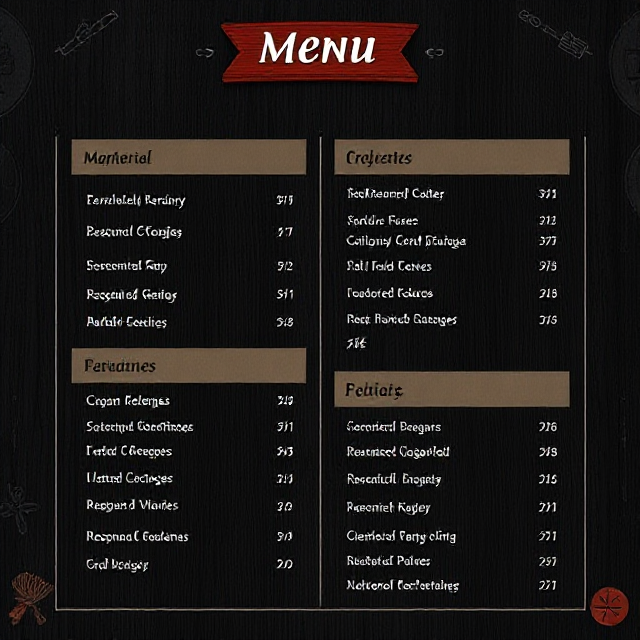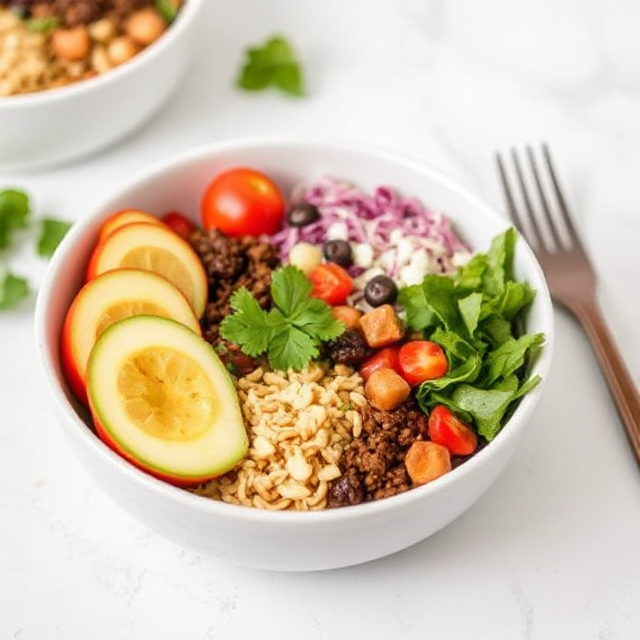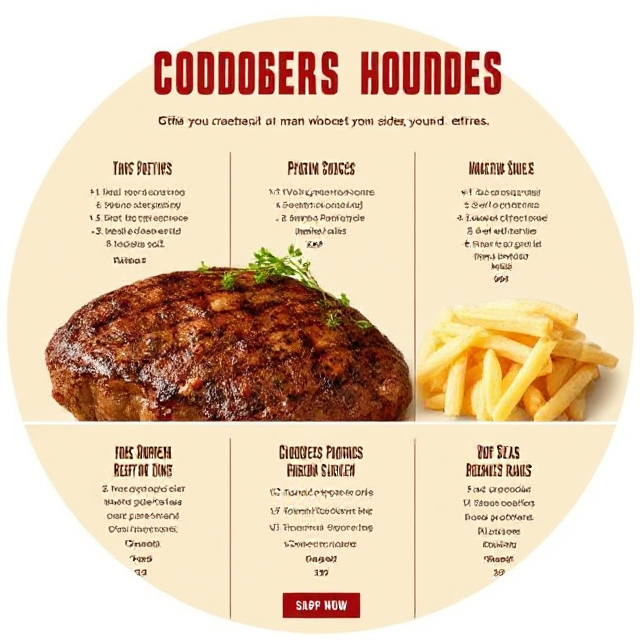Customizable Menu: Create Your Perfect Meal
A customizable menu offers diners the flexibility to tailor their meal choices to their preferences, making it an ideal option for those with dietary restrictions or specific taste preferences. Whether at a restaurant or through an online ordering system, a customizable menu allows customers to select from a variety of ingredients, portion sizes, and cooking styles. This personalized approach ensures that each meal meets the individual's needs, whether it's adjusting spice levels, swapping out sides, or selecting special toppings. Offering such menus enhances customer satisfaction, making it a popular choice in today's diverse culinary landscape.

Customizable Menu
A customizable menu is one that allows customers to modify or choose specific components of their meal, such as proteins, toppings, sauces, sides, and even portion sizes. This type of menu goes beyond traditional options, offering flexibility and variety for each diner.
Key Features:
- Protein Options: Choose from a selection of proteins (e.g., chicken, beef, tofu, seafood) based on your preferences.
- Base Choices: Select the base of your meal, such as a salad, rice bowl, sandwich, or pasta.
- Toppings and Add-ons: Customize your meal with a variety of toppings, like fresh vegetables, cheeses, nuts, or fruit.
- Sauces and Dressings: Pick from a variety of sauces, dressings, or dips to complement your meal.
- Portion Sizes: Adjust the portion sizes according to your hunger level or dietary needs.
Many restaurants offer a build-your-own-style meal option, where the customer can assemble their dish from a wide array of ingredients
1. Benefits of a Customizable Menu
1.1 Personalization and Satisfaction
A customizable menu caters to individual preferences, which means diners can enjoy meals tailored to their specific tastes. This leads to a more satisfying dining experience as customers are in control of what they eat.
- Example: If you prefer gluten-free, you can request gluten-free options for bases, sauces, or sides.
- Example: If you're vegetarian or vegan, you can select plant-based proteins and exclude animal products.
1.2 Dietary Flexibility
Customizable menus allow individuals to easily meet dietary restrictions or preferences, such as vegetarian, vegan, gluten-free, low-carb, or high-protein diets.
- Example: Someone following a low-carb diet might choose a lettuce wrap instead of a bread roll or opt for a cauliflower rice base.
- Example: Customers with food allergies can avoid specific ingredients or allergens and create a safe meal option.
1.3 Value for Money
Many customizable menus offer the option to adjust portion sizes, which can help customers control costs and reduce food waste. You can order a smaller meal if you're not very hungry or go larger if you want to satisfy your appetite.
- Example: A customizable taco bowl where you can choose the size of the base (small, medium, or large) and adjust the toppings according to your budget.
1.4 Creativity and Variety
A customizable menu encourages creativity by allowing customers to experiment with different flavor combinations and ingredients. This keeps the dining experience exciting and provides more variety than traditional, fixed-menu options.
- Example: Try mixing different sauces or experimenting with different cheese and topping combinations for pizzas, burgers, or salads.
2. Types of Customizable Menus
2.1 Build-Your-Own Meal Options
This is the most common form of customizable menus, where customers are given the option to choose from several categories to create a meal. Popular build-your-own options include:
- Burrito Bowls and Tacos: Customers can choose a base (e.g., rice, lettuce), protein (e.g., chicken, beef, or beans), toppings (e.g., guacamole, salsa, cheese), and sauces.
- Salads: Choose greens, proteins, vegetables, fruits, nuts, dressings, and toppings to create a personalized salad.
- Pizzas: Select your crust, sauce, cheese, toppings, and any extras (like spices, drizzles, or sides).
- Burgers: Choose the type of patty, bun, cheese, vegetables, sauces, and additional toppings (e.g., avocado, bacon, or fried onions).
2.2 à la Carte Menus
In some restaurants, diners can mix and match items from an à la carte menu, selecting individual components for a meal. This allows for greater flexibility and customization.
- Example: Ordering a steak and pairing it with any of the available sides, such as mashed potatoes, roasted vegetables, or sautéed greens.
- Example: Creating your own pasta by picking the type of pasta, sauce, and toppings like mushrooms, meatballs, or grilled chicken.
3. Customizable Menu for Special Dietary Needs
Customizable menus are ideal for people with special dietary requirements. Here are some examples of how customizable menus cater to different needs:
3.1 Gluten-Free Options
- Gluten-free individuals can select gluten-free bases (e.g., rice, lettuce) or request gluten-free buns, wraps, or pizza crusts.
- Example: A gluten-free pizza where customers choose from various toppings, sauces, and cheeses without worrying about gluten-containing ingredients.
3.2 Vegan and Vegetarian Options
- Vegans can build meals without animal products, opting for plant-based proteins like tofu, tempeh, or legumes, and dairy-free sauces.
- Example: A vegan burger with a plant-based patty, vegan cheese, and vegetable toppings, served with a side of fries.
3.3 Low-Carb and Keto-Friendly

- Those following a low-carb or keto diet can opt for meals with reduced carbs by choosing low-carb sides, skipping starches, and adding more protein and vegetables.
- Example: A keto-friendly bowl with grilled chicken, leafy greens, avocado, and olive oil-based dressing.
4. Popular Restaurants with Customizable Menus
Several popular restaurants have embraced the concept of customizable menus, making it easier for customers to create their ideal meals. Some of these include:
- Chipotle: Build-your-own burritos, bowls, tacos, and salads with a variety of proteins, toppings, and salsas.
- Subway: Choose from a variety of breads, meats, veggies, cheeses, sauces, and condiments to create personalized sandwiches or wraps.
- MOD Pizza: Build your pizza by selecting crust, sauce, cheese, and toppings with no extra charge for toppings.
- Sweetgreen: Customize your salad by selecting a base, proteins, toppings, and dressings to suit your tastes.
- Blaze Pizza: Customize your pizza with a choice of crust, sauce, cheese, and an array of toppings for a personalized experience.
- Texas Roadhouse : Offers a Build-Your-Own Meal that allows diners to personalize their meals by choosing from a variety of appetizers, sides, and entrees. Customers can create their perfect meal by selecting different protein options, sauces, and sides to suit their tastes and dietary preferences.

Conclusion: The Freedom of Customization
Customizable menus offer a world of possibilities for diners to create their perfect meal. Whether you’re accommodating dietary needs, exploring new flavors, or simply looking for a more personalized dining experience, customizable menus provide the flexibility to meet all your culinary desires. From fast casual chains to upscale restaurants, creating your perfect meal has never been easier or more enjoyable!
